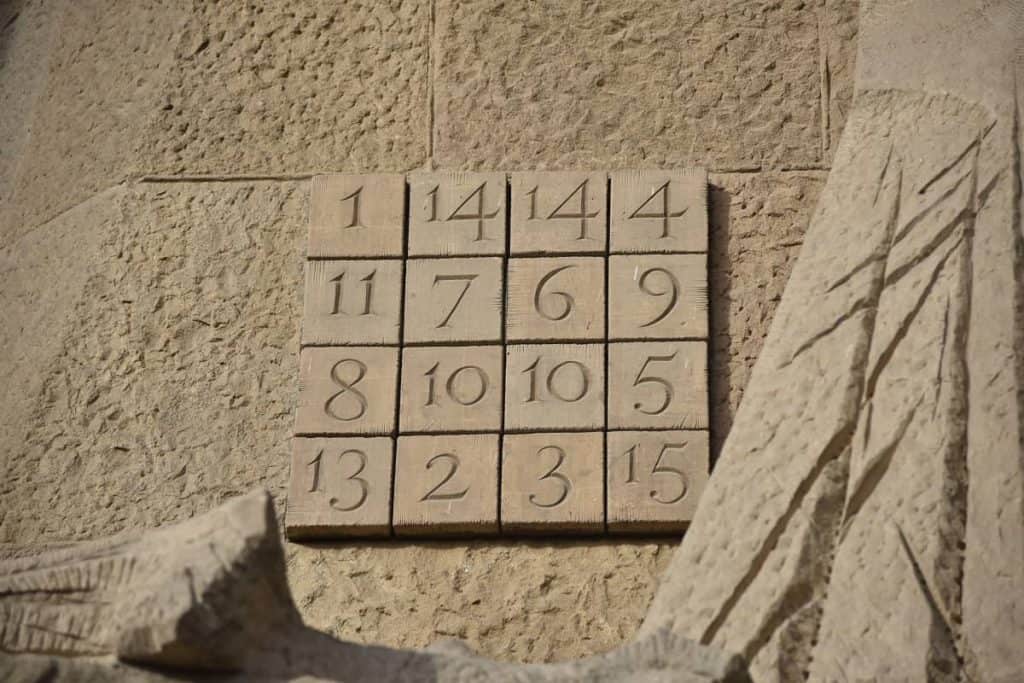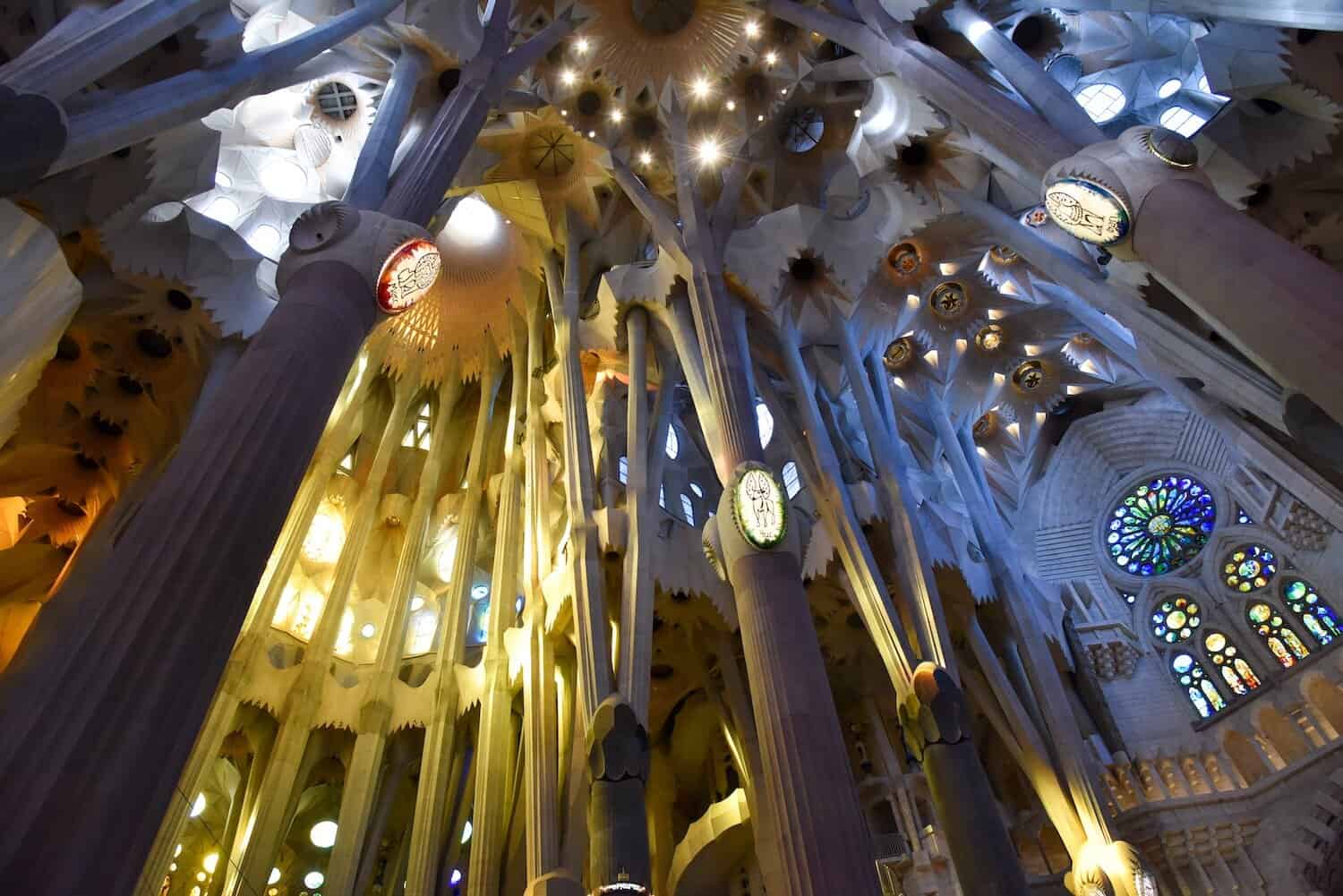This post may contain affiliate links.
The Basílica i Temple Expiatori de la Sagrada Família is a Roman Catholic basilica designed by Antoni Gaudí (1852–1926) and probably the most emblematic of all Barcelona’s attractions. It is the second most visited church in Europe after the Vatican and is among the top three attractions in Spain, along with the Prado Museum in Madrid and the Alhambra in Granada. La Sagrada Família consists of 4500 square metres and can hold 8000 people.
History
In 1866 Josep Maria Bocabella i Verdaguer, the owner of a religious bookstore, founded the Spiritual Association of Devotees of Saint Joseph. After returning from a visit to the Vatican in 1872, Bocabella wanted to build a church inspired by the basilica at Loreto.
In 1881, enabled by various donations, the Association purchased a 12,800m² plot of land, located between the streets of Marina, Provença, Sardenya, and Mallorca, to build a temple on.
Works began in 1882 following the Neo-gothic design drawn up by the architect Francisco de Paula del Villar y Lozano. He resigned from the post of chief architect and the job fell to Antoni Gaudí who began work on the church in 1883. Gaudí was young and unknown at that time, he had just turned 31.
Construction of Sagrada Familia began in 1882 and Gaudí began working on the project in 1883, dedicating over 40 years to its design. He combined Gothic and curvilinear Art Nouveau forms and the basilica became his life’s work.
Gaudí envisioned a “Bible in stone,” with each façade and tower narrating a story from the Christian faith. Though he planned every detail, he accepted that the project would extend beyond his lifetime, famously remarking, “My client is not in a hurry.”
Still incomplete, La Sagrada Família, was projected to be finished in 2026, the 100th anniversary of Gaudí’s death. However, due to the COVID-19 pandemic construction has been slowed and a new projected completion date has not yet been announced.

***
In 1914, Gaudí began to work exclusively on the Temple, to which he would dedicate the rest of his life. He died in an accident 1926 and he is buried in the crypt of the temple. His disciple Domènec Sugranyes then took over the project.
Construction was financed by private donations and work was interupted by the Spanish Civil War. In 1936, anarchists set fire to the crypt, broke into Gaudí’s workshop and destroyed many of Gaudí’s original plans, drawings and plaster models. It took 16 years of work to recreate the master model. George Orwell famously wrote in Homage to Catalonia, “[The anarchists] showed bad taste in not blowing it up when they had the chance.”
In 2005, the Nativity façade and crypt were named a UNESCO world heritage site. In 2010, Pope Benedict XVI consecrated the La Sagrada Familia as a basilica.

***
Gaudí’s Architectural Vision
The Sagrada Família blends Gothic and Art Nouveau styles with Gaudí’s unique organic architecture, inspired by nature. Key features include:
The Three Façades: The Nativity Façade on the east side is dedicated to the birth of Jesus, richly adorned with intricate sculptures of nature and biblical scenes. In contrast, the Passion Façade on the west is stark and angular, portraying Christ’s crucifixion and suffering. Still under construction, the Glory Façade on the south will represent the path to God, emphasizing themes of judgment, resurrection, and eternal life.
The Towers: When completed, the Sagrada Família will feature 18 towers, with 12 dedicated to the Apostles (already completed), 4 representing the Evangelists (currently under construction), 1 for the Virgin Mary (planned), and the tallest of all, a central 170-meter tower symbolizing Jesus Christ.
The Interior: Resembling a stone forest, with tree-like columns branching out to support the ceiling. Stained-glass windows fill the space with colored light, creating a surreal and deeply spiritual atmosphere.
The Magic Square

***
La Sagrada Família contains many hidden mysteries within its design. The magic square on the Passion façade is a unique 4×4 grid designed by sculptor Josep Maria Subirachs, inspired by Albrecht Dürer’s 1514 engraving Melencolia I. Unlike traditional magic squares, it does not use all numbers from 1 to 16 and repeats some numbers, but its magic constant is 33, symbolizing the age of Jesus Christ at his crucifixion. The square can be summed in multiple ways—rows, columns, diagonals, and other combinations—to total 33, with a total of 310 such combinations.
Additionally, the repeated numbers correspond to the initials INRI (Iesus Nazarenus Rex Iudaeorum), linking the square to the crucifixion narrative. The magic square blends mathematical intrigue with deep Christian symbolism.
The Foundation
La Sagrada Família is an expiatory temple, meaning it is built entirely from donations made by individuals as acts of faith and devotion. From its inception in 1882, the project has relied on private contributions rather than government or institutional funding. This unique financial model reflects the sacred and communal nature of the basilica’s mission.
The construction, preservation, and ongoing restoration of the basilica are overseen by the Junta Constructora del Temple Expiatori de la Sagrada Família—a nonprofit foundation established to manage every aspect of the temple’s development, from architectural planning to financial administration.
Practical Details
La Sagrada Família is located in the Eixample district of Barcelona and is easily accessible by public transportation, with the nearby metro stop Sagrada Família (L2 and L5). To avoid long lines, it’s best to book tickets online in advance, with options that include guided tours and access to the towers for panoramic views of the city.
Opening hours vary by season, typically from 9:00 AM to 8:00 PM in summer and until 6:00 PM in winter. Visitors should dress modestly, as the basilica is an active place of worship, and note that security checks are in place at the entrance.
FAQ
La Sagrada Família is situated in the Barcelona district of Eixample and in the neighborhood also called Sagrada Família.
The completion of La Sagrada Família was planned to be in 2026, the centenary of architect Antoni Gaudí’s death. However, due to the pause in construction resulting from the COVID-19 pandemic, the temple will not be finished by then. A new projected completion date has not yet been announced.
On competion the central tower will reach 170 meters tall.
Masses are free for the faithful. Mass is celebrated every Sunday at nine in the morning and on Saturdays at eight in the afternoon. It is recommended to go an hour early.
